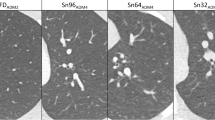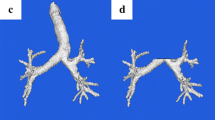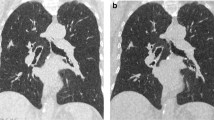Abstract
Objectives
To prospectively assess the impact of sinogram-affirmed iterative reconstruction (SAFIRE) on image quality of nonenhanced low-dose lung CT as compared to filtered back projection (FBP).
Methods
Nonenhanced low-dose chest CT (tube current-time product: 30 mAs) was performed on 30 patients at 100 kVp and on 30 patients at 80 kVp. Images were reconstructed with FBP and SAFIRE. Two blinded, independent readers measured image noise; two readers assessed image quality of normal anatomic lung structures on a five-point scale. Radiation dose parameters were recorded.
Results
Image noise in datasets reconstructed with FBP (57.4 ± 15.9) was significantly higher than with SAFIRE (31.7 ± 9.8, P < 0.001). Image quality was significantly superior with SAFIRE than with FBP (P < 0.01), without significant difference between FBP at 100 kVp and SAFIRE at 80 kVp (P = 0.68). Diagnostic image quality was present with FBP in 96% of images at 100 kVp and 88% at 80 kVp, and with SAFIRE in 100% at 100 kVp and 98% at 80 kVp. There were significantly more datasets with diagnostic image quality with SAFIRE than with FBP (P < 0.01). Mean CTDIvol and effective doses were 1.5 ± 0.7 mGy·cm and 0.7 ± 0.2 mSv at 100 kVp, and 1.4 ± 2.8 mGy·cm and 0.5 ± 0.2 mSv at 80 kVp (P < 0.001, both).
Conclusions
Use of SAFIRE in low-dose lung CT reduces noise, improves image quality, and renders more studies diagnostic as compared to FBP.
Key Points
• Low-dose computed tomography is an important thoracic investigation tool.
• Radiation dose can be less than 1 mSv with iterative reconstructions.
• Iterative reconstructions render more low-dose lung CTs diagnostic compared to conventional reconstructions.







Similar content being viewed by others
References
National Lung Screening Trial Research Team, Aberle DR, Adams AM, et al (2011) Reduced lung-cancer mortality with low-dose computed tomographic screening. N Engl J Med 365:395–409
Aberle DR, Berg CD, Black WC et al (2011) The National Lung Screening Trial: overview and study design. Radiology 258:243–253
Baldwin DR, Duffy SW, Wald NJ, Page R, Hansell DM, Field JK (2011) UK Lung Screen (UKLS) nodule management protocol: modelling of a single screen randomised controlled trial of low-dose CT screening for lung cancer. Thorax 66:308–313
Bankier AA, Tack D (2010) Dose reduction strategies for thoracic multidetector computed tomography: background, current issues, and recommendations. J Thorac Imaging 25:278–288
Baumueller S, Alkadhi H, Stolzmann P et al (2011) Computed tomography of the lung in the high-pitch mode: is breath holding still required? Invest Radiol 46:240–245
Cereser L, Zuiani C, Graziani G et al (2010) Impact of clinical data on chest radiography sensitivity in detecting pulmonary abnormalities in immunocompromised patients with suspected pneumonia. Radiol Med 115:205–214
Christner JA, Zavaletta VA, Eusemann CD, Walz-Flannigan AI, McCollough CH (2010) Dose reduction in helical CT: dynamically adjustable z-axis X-ray beam collimation. AJR Am J Roentgenol 194:W49–55
Committee CDDICC (2008) The measurement, reporting, and management of radiation dose in CT. The American Association of Physicists in Medicine report no. 96. AAPM, College Park, MD
Costello P (1994) Thoracic helical CT. Radiographics 14:913–918
Heussel CP, Kauczor HU, Heussel G, Fischer B, Mildenberger P, Thelen M (1997) Early detection of pneumonia in febrile neutropenic patients: use of thin-section CT. AJR Am J Roentgenol 169:1347–1353
Kalender WA, Buchenau S, Deak P et al (2008) Technical approaches to the optimisation of CT. Phys Med 24:71–79
Kalra MK, Maher MM, Sahani DV et al (2003) Low-dose CT of the abdomen: evaluation of image improvement with use of noise reduction filters—pilot study. Radiology 228:251–256
Kazerooni EA (2001) High-resolution CT of the lungs. AJR Am J Roentgenol 177:501–519
Leipsic J, Nguyen G, Brown J, Sin D, Mayo JR (2010) A prospective evaluation of dose reduction and image quality in chest CT using adaptive statistical iterative reconstruction. AJR Am J Roentgenol 195:1095–1099
McCollough CH, Bruesewitz MR, Kofler JM Jr (2006) CT dose reduction and dose management tools: overview of available options. Radiographics 26:503–512
McNitt-Gray MF (2002) AAPM/RSNA physics tutorial for residents: topics in CT. Radiation dose in CT. Radiographics 22:1541–1553
Moscariello A, Takx RA, Schoepf UJ et al (2011) Coronary CT angiography: image quality, diagnostic accuracy, and potential for radiation dose reduction using a novel iterative image reconstruction technique-comparison with traditional filtered back projection. Eur Radiol 21:2130–2138
Naidich DP (2010) High-resolution computed tomography of the pulmonary parenchyma: past, present, and future? J Thorac Imaging 25:32–33
Noel PB, Fingerle AA, Renger B, Munzel D, Rummeny EJ, Dobritz M (2011) Initial performance characterization of a clinical noise-suppressing reconstruction algorithm for MDCT. AJR Am J Roentgenol 197:1404–1409
Paul NS, Blobel J, Prezelj E et al (2010) The reduction of image noise and streak artifact in the thoracic inlet during low dose and ultra-low dose thoracic CT. Phys Med Biol 55:1363–1380
Pontana F, Duhamel A, Pagniez J et al (2011) Chest computed tomography using iterative reconstruction vs filtered back projection (part 2): image quality of low-dose CT examinations in 80 patients. Eur Radiol 21:636–643
Pontana F, Pagniez J, Flohr T et al (2011) Chest computed tomography using iterative reconstruction vs filtered back projection (part1): evaluation of image noise reduction in 32 patients. Eur Radiol 21:627–635
Prakash P, Kalra MK, Ackman JB et al (2010) Diffuse lung disease: CT of the chest with adaptive statistical iterative reconstruction technique. Radiology 256:261–269
Prakash P, Kalra MK, Digumarthy SR et al (2010) Radiation dose reduction with chest computed tomography using adaptive statistical iterative reconstruction technique: initial experience. J Comput Assist Tomogr 34:40–45
Schueller G, Matzek W, Kalhs P, Schaefer-Prokop C (2005) Pulmonary infections in the late period after allogeneic bone marrow transplantation: chest radiography versus computed tomography. Eur J Radiol 53:489–494
Thibault JB, Sauer KD, Bouman CA, Hsieh J (2007) A three-dimensional statistical approach to improved image quality for multislice helical CT. Med Phys 34:4526–4544
Vock P, Soucek M, Daepp M, Kalender WA (1990) Lung: spiral volumetric CT with single-breath-hold technique. Radiology 176:864–867
Winklehner A, Goetti R, Baumueller S et al (2011) Automated attenuation-based tube potential selection for thoracoabdominal computed tomography angiography: improved dose effectiveness. Invest Radiol 46:767–773
Winklehner A, Karlo C, Puippe G et al (2011) Raw data-based iterative reconstruction in body CTA: evaluation of radiation dose saving potential. Eur Radiol 21:2521–2526
Yanagawa M, Honda O, Yoshida S et al (2010) Adaptive statistical iterative reconstruction technique for pulmonary CT: image quality of the cadaveric lung on standard- and reduced-dose CT. Acad Radiol 17:1259–1266
Author information
Authors and Affiliations
Corresponding author
Rights and permissions
About this article
Cite this article
Baumueller, S., Winklehner, A., Karlo, C. et al. Low-dose CT of the lung: potential value of iterative reconstructions. Eur Radiol 22, 2597–2606 (2012). https://doi.org/10.1007/s00330-012-2524-0
Received:
Revised:
Accepted:
Published:
Issue Date:
DOI: https://doi.org/10.1007/s00330-012-2524-0




